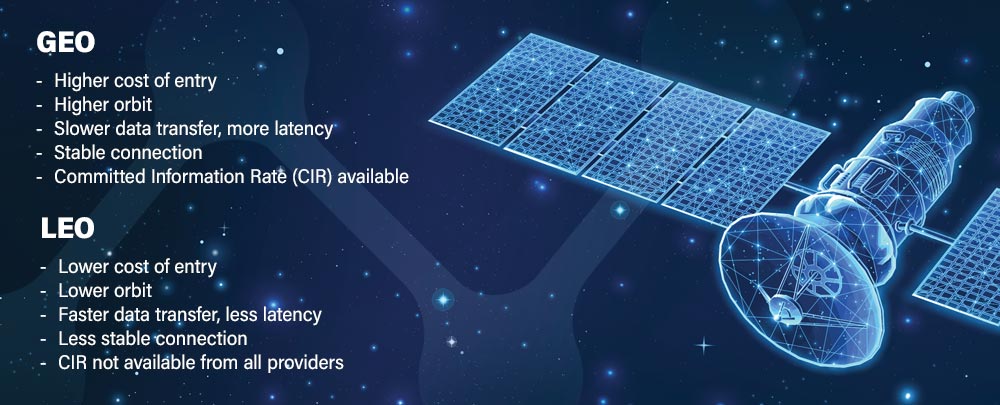Organizations of all types have historically relied on satellite data services to support their mobile operations. In recent years, in spite of near-ubiquitous cellular coverage and expanding 5G networks, the need for supplemental and gap coverage hasn’t disappeared.
In fact, at the same time as cell technologies and networks are rapidly advancing, a sea change is happening with satellite services. Whether your organization has been a long-time satellite data user, or you are considering adopting satellite as a new capability, it’s the perfect time to review your needs and mission requirements and consider the available options.
First there was GEO
Until just a few years ago, having satellite data capabilities required significant expenditures and large dish antennas. The option for satellite service was via Geostationary Orbit (GEO) satellites, which orbit 22,236 miles above Earth.
Transfer rates in these systems was slower than terrestrial options like wired Internet Service Providers (ISPs), and later 3G/4G cell and ISPs with fiber. So, working with large data transfers was cumbersome. High latency — the delay as data passes through a network — because of the distances from ground to satellite made streaming and teleconferencing difficult.
Today, GEO data speeds and bandwidth have improved, and gear has gotten more compact at the same time. Antennas can be as small as a meter and are available in low-profile (“flat”) form factors. Latency challenges still exist (radio waves move at the speed of light, and that is a constant), and the cost of entry can be prohibitive for some organizations.
Enter LEO
The advent of Low Earth Orbit (LEO) constellations from providers like Starlink™ has shaken up the satellite services world. Because these satellites are much closer to the Earth’s surface (600 miles), latency is reduced to levels comparable to terrestrial data services. LEO’s phased array antennas also have a compact form factor – some even fitting in a backpack.
Organizations for whom satellite data was previously inaccessible are exploring LEO, and long-time GEO users are considering making a switch, either completely or to supplement their GEO services. With high data speeds, low latency, good bandwidth, and lower cost of entry, LEO is raising eyebrows.

Putting the Pieces Together
Though Starlink™ is the most well-known LEO service, other providers are also available and could be a better fit depending on your mission requirements. It may be that all you need is an off-the-shelf commercial satellite terminal solution. The apparent simplicity of LEO is attractive, but before making the leap, consider these questions:
- How will LEO data be integrated into new or existing mobile IT infrastructure?
- Do you require satellite data on the move, or only when stationary?
- Is a consumer-grade solution adequate, or do you need robust hardware and guaranteed data rates?
- Do you have the expertise to install and support your satellite system with minimal help?
- Are you comfortable with credit card billing and non-prioritized tech support?
By examining these questions, and considering the criticality of your mission, you may decide an experienced partner would be your best guide in the adoption of LEO satellite data services.
The Managed Services Advantage
Managed services can simplify the transition to LEO and reduce risk and long-term cost. A good managed services partner will work with you to understand mission requirements and map out a hardware, software, and support profile that suits. There should be no “one-size-fits-all” approach. Different requirements will drive different solution sets.
Additionally, your partner should be a resource for getting satellite data properly integrated into new or existing mobile infrastructure – from physical installation to IT configuration. They will also provide technical support above and beyond consumer-oriented “call center” options, which may fall short in critical scenarios.
Finally, leveraging a managed services agreement will open up billing and budgeting options not available at the consumer and small accounts levels. Data rates can be packaged and billed with existing services from other platforms, and data contracts can be customized for your needs.
Consider Nomad GCS
With over two decades in mission-critical mobile SATCOM and solutions integration, Nomad has the experience and expertise to set your organization up for success. Our relationships with top LEO and GEO SATCOM providers gives us an advantage in creating right-sized solutions that are cost-effective and perform without fail. And, the 24/7 x 365 support of Nomad’s managed services simply cannot be matched.
More Resources
Learn about mobile Satellite Communications (SATCOM) from Nomad GCS: Click Here
Learn about AlwaysUp™ Connectivity Suite, Nomad’s managed connectivity services: Click Here

